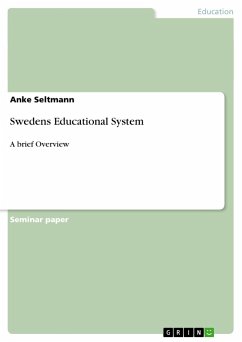Seminar paper from the year 2006 in the subject Pedagogy - School System, Educational and School Politics, grade: B, Uppsala University, course: Education and Reform Strategies in Sweden, language: English, abstract: IntroductionSweden is the third largest country in the European Union after France and Spain. It has approximately 9 million inhabitants thereof ca. 1 million immigrants . Till the end of August 2006 there had 64,681 Immigrants been given excess to Sweden. So the population is heterogeneous and is concentrated in mainly three areas of the country. "In an international comparison, the Swedish overall rate of participation in education is one of the highest." The basic principle of education in Sweden is equality. This means equality of opportunities / access but also equality of outcomes / results. Everybody in Sweden must have access to an equivalent, uniform education, regardless of sex, irrespective of their social or ethnic backgrounds or their place of residence, because a well-educated society is a prerequisite for the expansion of the country's economic and the further development of the Swedish welfare state. There is also a big awareness of the importance of research and development. Due to this the cost for the education system in Sweden are very high, among the highest in the world .In the following pages I want to outline the Swedish educational system. I will start with a sketch of the reforms and according to the lights of this essay I will begin with the 20th century. The goal is to shed light on the needs of the society and on political reasons of the reforms. Furthermore I will represent an overview of the today's system and discuss the differences between the "old" and the "new" strategies as well as advantages and disadvantages. The History of Sweden's Education - short ReviewIn the 19th century Sweden rapidly transformed from an agricultural, traditional society into an industrialised society. During this industrialisation and also democratisation the well-known Swedish model developed (1920s). By this is the specific model of a social welfare system is meant. It was characterized by centralism, universalism and cooperation between the capital and labour (consensus). At that time the focus was on developing a (social) welfare system this includes also focus on the education system. In this inclusive and centralised welfare state, science was a tool for modernising society in large reforms. The peak was reached in the 1970s. During this decade the demands for decentralisation as well as pluralism increased.[...]
Hinweis: Dieser Artikel kann nur an eine deutsche Lieferadresse ausgeliefert werden.
Hinweis: Dieser Artikel kann nur an eine deutsche Lieferadresse ausgeliefert werden.








